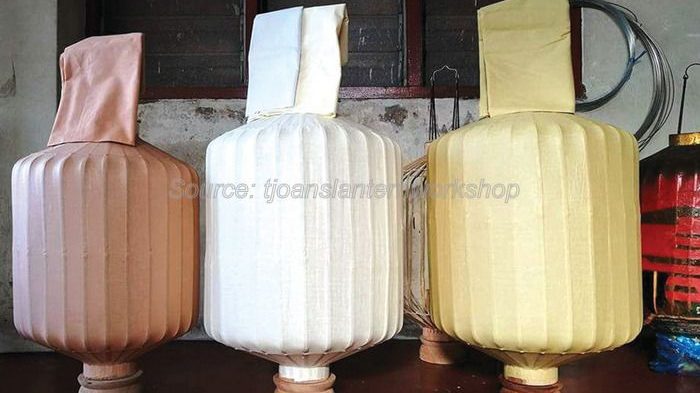Cover Story: Crafting Tradition: Surname Lanterns


By Tan Mei Kuan
A beacon for cultural heritage, the surname lantern (also goes by the name of umbrella lantern or Hock Chew lantern) is illuminating Ipoh and beyond, thanks to the effort of Chuen Mun Wai, an Ipoh boy. In an exclusive one-on-one with Ipoh Echo, the 39-year-old owner of Tjoan’s Lantern Workshop unveils the ins and outs of the craft with only four (or less) such makers left in Malaysia. With pictures of the nocturnal art pieces galore, read on and let there be light!


A Beacon for Cultural Heritage: Illuminating Ipoh and Beyond…
Serendipitous Beginnings


Foreseeing its business viability, he started off by becoming a part-time middleman, handling lantern orders from temples outside of Penang for the late artisan named Lee. Being intensely inquisitive, Chuen would always have a few questions ready for the late craftsman regarding lantern-making each time they met.
Next, he got into the making process wholeheartedly to fulfil the orders that kept coming after the master’s unfortunate passing. Putting two and two together, he pieced together all that he had learnt like a puzzle.




Initially, Chuen worked from home accepting only limited orders. Tjoan’s Lantern Workshop was established three years ago to accommodate the increasing demand.
The Origins and Traditions


“The bamboo frame of the umbrella lantern is similar to that of the Chinese oil-paper umbrellas, thus its name. It is also known as surname lantern because the Baba Nyonya families would hang the lanterns, with their surname and birthplace of that surname painted on, during joyful occasions and days of ancestral prayer,” he explained. Plus, some lanterns tell stories while some are painted with auspicious sayings or phrases to teach good manners.
Chuen was told by the senior craftsmen that the lanterns were brought here during the Tang dynasty.


Stages of Lantern-Making
The two common shapes for a surname lantern are cylindrical and round while the materials encompass bamboo, wood block, DIY glue made of tapioca and agar as waterproof glaze to facilitate painting. Hung both outdoors and indoors, lanterns usually come in pairs except for the round one which is hung individually.
Candles which were used to light up the lanterns in the past are now replaced with electric bulbs.


Adopting traditional methods, each lantern is painstakingly handmade from scratch by Chuen himself starting from tying the bamboo ribs with threads, wrapping the 100% cotton cloth around the frame, colouring right up to finishing. The coating forms a protective layer which is water and sun resistant thus making it easy to clean. Besides that, the glaze will result in more vibrant colours.
“Painting the lantern well is the most time-consuming part,” he pointed out. Therefore, Johnny Wong Kam Weng assists him in painting the lanterns with water paint. Painting for over 30 years now, the self-taught artist hailing from Teluk Intan used to paint movie promotional canvases back in the 1980s. Other than lanterns, he currently paints murals for temples and schools.
Johnny told Ipoh Echo, “I have painted many lanterns for Chuen and each one is a memorable masterpiece. For instance, depicting the Eight Immortals from Chinese mythology takes up a great deal of time as each one of them has a distinctive facial expression.”


“I had lanterns put up on Market Lane (also known as Third Concubine Lane) that tell the story of the beginning of Ipoh,” the amiable Chuen enthused.
With customers from as far as Thailand, Taiwan, Indonesia and Singapore, a single lantern can take him between seven days to three months to complete. If well cared for, it’s no wonder that his durable lanterns can last more than 80 years!
“I receive the most orders as the community gears up for Mooncake Festival and Chinese New Year. During Chinese New Year, the red colour is preferred. The other usual colours are the vintage tea, gold/yellow and white. Once I made three white-and-black lanterns and five yellow-and-red ones for the interior of a popular contemporary cafe in Kedah called Caffe Diem. Those were creations which saw the fusion of traditional and modern elements,” he highlighted.




By reusing the sturdy bamboo frames of old lanterns, he breathes new life into the nocturnal art pieces. He also makes the smaller festival lantern in the shape of the ancient Chinese coin. “To integrate elements of the local culture and Chinese culture, I reuse torn and thus unsalable batik, dating from pre-Merdeka days from local fabric stores to make the lanterns instead of the usual coloured cellophane sheets,” he added. He also has knowledge of the Teochew lanterns.




Keeping the Craft Alive


“There are many who are interested to learn but they soon discover how time-consuming it is. For instance, cutting the bamboo to size manually which takes up to three days, will bore most apprentices. However, this is an inevitable step in making the lantern,” Chuen said.




When he has time to spare he will organise festival lantern workshops, using wooden ice cream sticks, in Ipoh and Penang for a minimal fee. In Ipoh, he has held demonstrations at SO-MN Oriental Goods & Tea, Masjid Cina and the Culture & Art Corridor at Market Lane. For updates, stay tuned to his Facebook page: tjoanslanternworkshop.




